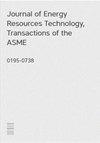用于聚光太阳能发电的双金属高温回热器的多目标优化
IF 2.4
3区 工程技术
Q3 ENERGY & FUELS
Journal of Energy Resources Technology-transactions of The Asme
Pub Date : 2023-06-20
DOI:10.1115/1.4062522
引用次数: 0
摘要
超临界CO2闭式布雷顿循环是聚光太阳能应用中未来动力循环设计的主要候选,高温回热器在实现其高热效率方面发挥着至关重要的作用。印刷电路热交换器(PCHEs)通常被选择用于这一角色,因为它们在高温和高压下的热液压和机械性能,同时保持紧凑。然而,由于在这些应用中需要高性能材料,pch的成本可能很高,并且热交换器的内部几何形状受到其制造工艺的限制。增材制造的热交换器可以解决这两个缺点。这项工作提出了一个模块化的双金属高温回热器与集成的集头将生产与增材制造。从现有的PCHE通道几何形状开始,开发了一维换热器模型。然后,采用多目标优化方法,在限制实验设备尺寸的同时,最大限度地提高设备的传热效率。优化后出现了两种不同的通道几何形状。最优设计可实现高达88%的效率,压降可忽略不计。对于实验室规模的PCHEs来说,由于换热器壁面的轴向传热而导致的效率下降是一个显著的问题,这里获得的优化设计可以最大限度地减少其有害影响。灵敏度分析表明,在非设计工况下,当轴向传导较大时,回热器的效率对质量流量变化的敏感性较低,而增加回热器长度则容易提高回热器的效率。本文章由计算机程序翻译,如有差异,请以英文原文为准。
Multi-Objective Optimization of a Bi-Metal High-Temperature Recuperator for Application in Concentrating Solar Power
Abstract Supercritical CO2 closed Brayton cycles are a major candidate for future power cycle designs in concentrating solar power applications, with high-temperature recuperators playing an essential role in realizing their high thermal efficiency. Printed circuit heat exchangers (PCHEs) are often chosen for this role due to their thermal-hydraulic and mechanical performance at high temperatures and pressures, all while remaining compact. However, PCHEs can be costly because of the high-performance materials demanded in these applications, and the heat exchanger internal geometry is restricted by their manufacturing process. Additively manufactured heat exchangers can address both of these shortcomings. This work proposes a modular bi-metal high-temperature recuperator with integrated headers to be produced with additive manufacturing. Beginning with existing PCHE channel geometries, a 1D heat exchanger model is developed. Then, multi-objective optimization is used to maximize the heat transfer effectiveness of a lab-scale device while limiting its size. Two distinct channel geometries emerge from the optimization. Optimal designs achieve up to 88% effectiveness with negligible pressure drop. Deterioration of effectiveness due to axial conduction of heat in the heat exchanger walls is found to be a notable problem for lab-scale PCHEs, and the optimal designs obtained here minimize its detrimental effects. A sensitivity analysis reveals that the effectiveness of the recuperator is much less sensitive to variation in mass flowrate in off-design operation when axial conduction is significant, while increasing the length of the device easily increases effectiveness.
求助全文
通过发布文献求助,成功后即可免费获取论文全文。
去求助
来源期刊
CiteScore
6.40
自引率
30.00%
发文量
213
审稿时长
4.5 months
期刊介绍:
Specific areas of importance including, but not limited to: Fundamentals of thermodynamics such as energy, entropy and exergy, laws of thermodynamics; Thermoeconomics; Alternative and renewable energy sources; Internal combustion engines; (Geo) thermal energy storage and conversion systems; Fundamental combustion of fuels; Energy resource recovery from biomass and solid wastes; Carbon capture; Land and offshore wells drilling; Production and reservoir engineering;, Economics of energy resource exploitation

 求助内容:
求助内容: 应助结果提醒方式:
应助结果提醒方式:


